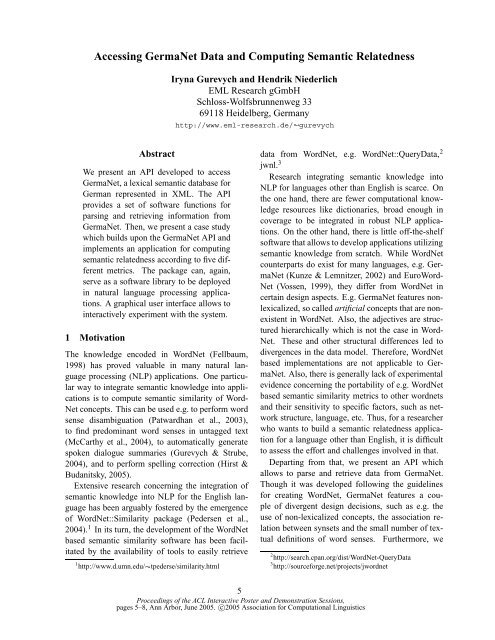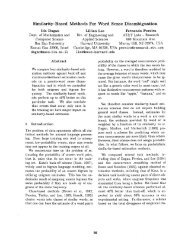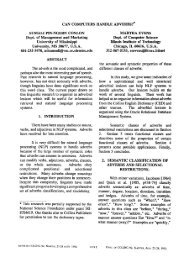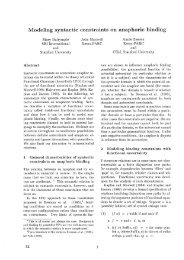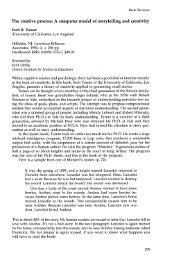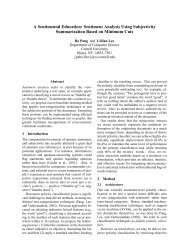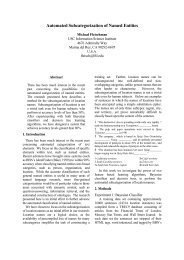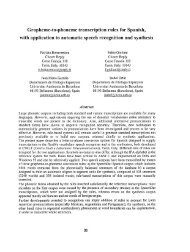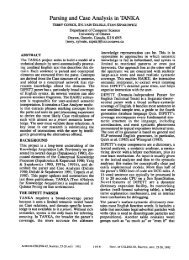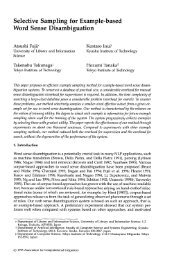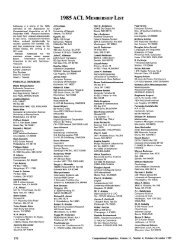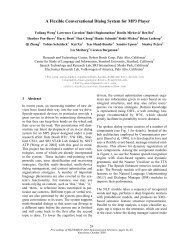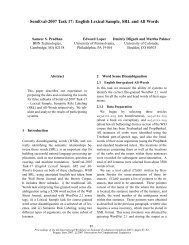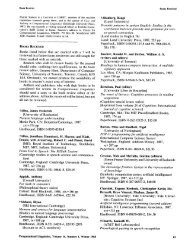Accessing GermaNet Data and Computing Semantic Relatedness
Accessing GermaNet Data and Computing Semantic Relatedness
Accessing GermaNet Data and Computing Semantic Relatedness
You also want an ePaper? Increase the reach of your titles
YUMPU automatically turns print PDFs into web optimized ePapers that Google loves.
<strong>Accessing</strong> <strong>GermaNet</strong> <strong>Data</strong> <strong>and</strong> <strong>Computing</strong> <strong>Semantic</strong> <strong>Relatedness</strong><br />
Abstract<br />
We present an API developed to access<br />
<strong>GermaNet</strong>, a lexical semantic database for<br />
German represented in XML. The API<br />
provides a set of software functions for<br />
parsing <strong>and</strong> retrieving information from<br />
<strong>GermaNet</strong>. Then, we present a case study<br />
which builds upon the <strong>GermaNet</strong> API <strong>and</strong><br />
implements an application for computing<br />
semantic relatedness according to five different<br />
metrics. The package can, again,<br />
serve as a software library to be deployed<br />
in natural language processing applications.<br />
A graphical user interface allows to<br />
interactively experiment with the system.<br />
1 Motivation<br />
The knowledge encoded in WordNet (Fellbaum,<br />
1998) has proved valuable in many natural language<br />
processing (NLP) applications. One particular<br />
way to integrate semantic knowledge into applications<br />
is to compute semantic similarity of Word-<br />
Net concepts. This can be used e.g. to perform word<br />
sense disambiguation (Patwardhan et al., 2003),<br />
to find predominant word senses in untagged text<br />
(McCarthy et al., 2004), to automatically generate<br />
spoken dialogue summaries (Gurevych & Strube,<br />
2004), <strong>and</strong> to perform spelling correction (Hirst &<br />
Budanitsky, 2005).<br />
Extensive research concerning the integration of<br />
semantic knowledge into NLP for the English language<br />
has been arguably fostered by the emergence<br />
of WordNet::Similarity package (Pedersen et al.,<br />
2004). 1 In its turn, the development of the WordNet<br />
based semantic similarity software has been facilitated<br />
by the availability of tools to easily retrieve<br />
1 http://www.d.umn.edu/ tpederse/similarity.html<br />
Iryna Gurevych <strong>and</strong> Hendrik Niederlich<br />
EML Research gGmbH<br />
Schloss-Wolfsbrunnenweg 33<br />
69118 Heidelberg, Germany<br />
http://www.eml-research.de/ gurevych<br />
data from WordNet, e.g. WordNet::Query<strong>Data</strong>, 2<br />
jwnl. 3<br />
Research integrating semantic knowledge into<br />
NLP for languages other than English is scarce. On<br />
the one h<strong>and</strong>, there are fewer computational knowledge<br />
resources like dictionaries, broad enough in<br />
coverage to be integrated in robust NLP applications.<br />
On the other h<strong>and</strong>, there is little off-the-shelf<br />
software that allows to develop applications utilizing<br />
semantic knowledge from scratch. While WordNet<br />
counterparts do exist for many languages, e.g. <strong>GermaNet</strong><br />
(Kunze & Lemnitzer, 2002) <strong>and</strong> EuroWord-<br />
Net (Vossen, 1999), they differ from WordNet in<br />
certain design aspects. E.g. <strong>GermaNet</strong> features nonlexicalized,<br />
so called artificial concepts that are nonexistent<br />
in WordNet. Also, the adjectives are structured<br />
hierarchically which is not the case in Word-<br />
Net. These <strong>and</strong> other structural differences led to<br />
divergences in the data model. Therefore, WordNet<br />
based implementations are not applicable to <strong>GermaNet</strong>.<br />
Also, there is generally lack of experimental<br />
evidence concerning the portability of e.g. WordNet<br />
based semantic similarity metrics to other wordnets<br />
<strong>and</strong> their sensitivity to specific factors, such as network<br />
structure, language, etc. Thus, for a researcher<br />
who wants to build a semantic relatedness application<br />
for a language other than English, it is difficult<br />
to assess the effort <strong>and</strong> challenges involved in that.<br />
Departing from that, we present an API which<br />
allows to parse <strong>and</strong> retrieve data from <strong>GermaNet</strong>.<br />
Though it was developed following the guidelines<br />
for creating WordNet, <strong>GermaNet</strong> features a couple<br />
of divergent design decisions, such as e.g. the<br />
use of non-lexicalized concepts, the association relation<br />
between synsets <strong>and</strong> the small number of textual<br />
definitions of word senses. Furthermore, we<br />
2 http://search.cpan.org/dist/WordNet-Query<strong>Data</strong><br />
3 http://sourceforge.net/projects/jwordnet<br />
5<br />
Proceedings of the ACL Interactive Poster <strong>and</strong> Demonstration Sessions,<br />
pages 5–8, Ann Arbor, June 2005. c○2005 Association for Computational Linguistics
uild an application accessing the knowledge in <strong>GermaNet</strong><br />
<strong>and</strong> computing semantic relatedness of <strong>GermaNet</strong><br />
word senses according to five different metrics.<br />
Three of these metrics have been adapted from<br />
experiments on English with WordNet, while the remaining<br />
two are based on automatically generated<br />
definitions of word senses <strong>and</strong> were developed in the<br />
context of work with <strong>GermaNet</strong>.<br />
2 <strong>GermaNet</strong> API<br />
The API for accessing <strong>GermaNet</strong> has to provide<br />
functions similar to the API developed for WordNet.<br />
We evaluated the C-library distributed together with<br />
<strong>GermaNet</strong> V4.0 <strong>and</strong> the XML encoded version<br />
of <strong>GermaNet</strong> (Lemnitzer & Kunze, 2002). As we<br />
wanted the code to be portable across platforms, we<br />
built upon the latter. The XML version of <strong>GermaNet</strong><br />
is parsed with the help of the Apache Xerces parser,<br />
http://xml.apache.org/ to create a JAVA object representing<br />
<strong>GermaNet</strong>. For stemming the words, we use<br />
the functionality provided by the Porter stemmer<br />
for the German language, freely available from<br />
http://snowball.tartarus.org/german/stemmer.html.<br />
Thus, the <strong>GermaNet</strong> object exists in two versions,<br />
the original one, where the information can be<br />
accessed using words, <strong>and</strong> the stemmed one, where<br />
the information can be accessed using word stems.<br />
We implemented a range of JAVA based methods<br />
for querying the data. These methods are organized<br />
around the notions of word sense <strong>and</strong> synset.<br />
On the word sense (WS) level, we have the following<br />
methods: getAntonyms() retrieves all antonyms<br />
of a given WS; getArtificial() indicates whether a<br />
WS is an artificial concept; getGrapheme() gets a<br />
graphemic representation of a WS; getParticipleOf()<br />
retrieves the WS of the verb that the word sense is<br />
a participle of; getPartOfSpeech() gets the part of<br />
speech associated with a WS; getPertonym() gives<br />
the WS that the word sense is derived from; get-<br />
ProperName() indicates whether the WS is a proper<br />
name; getSense() yields the sense number of a WS in<br />
<strong>GermaNet</strong>; getStyle() indicates if the WS is stylistically<br />
marked; getSynset() returns the corresponding<br />
synset; toString() yields a string representing a WS.<br />
On the synset level, the following information can<br />
be accessed: getAssociations() returns all associations;<br />
getCausations() gets the effects that a given<br />
6<br />
synset is a cause of; getEntailments() yields synsets<br />
that entail a given synset; getHolonyms(), getHyponyms(),<br />
getHypernyms(), getMeronyms() return a<br />
list of holonyms, hyponyms, immediate hypernyms,<br />
<strong>and</strong> meronyms respectively; getPartOfSpeech() returns<br />
the part of speech associated with word senses<br />
of a synset; getWordSenses() returns all word senses<br />
constituting the synset; toString() yields a string representation<br />
of a synset.<br />
The metrics of semantic relatedness are designed<br />
to employ this API. They are implemented as classes<br />
which use the API methods on an instance of the<br />
<strong>GermaNet</strong> object.<br />
3 <strong>Semantic</strong> <strong>Relatedness</strong> Software<br />
In <strong>GermaNet</strong>, nouns, verbs <strong>and</strong> adjectives are structured<br />
within hierarchies of is-a relations. 4 <strong>GermaNet</strong><br />
also contains information on additional<br />
lexical <strong>and</strong> semantic relations, e.g. hypernymy,<br />
meronymy, antonymy, etc. (Kunze & Lemnitzer,<br />
2002). A semantic relatedness metric specifies to<br />
what degree the meanings of two words are related<br />
to each other. E.g. the meanings of Glas (Engl.<br />
glass) <strong>and</strong> Becher (Engl. cup) will be typically classified<br />
as being closely related to each other, while<br />
the relation between Glas <strong>and</strong> Juwel (Engl. gem)<br />
is more distant. <strong>Relatedness</strong>Comparator is a class<br />
which takes two words as input <strong>and</strong> returns a numeric<br />
value indicating semantic relatedness for the<br />
two words. <strong>Semantic</strong> relatedness metrics have been<br />
implemented as descendants of this class.<br />
Three of the metrics for computing semantic relatedness<br />
are information content based (Resnik, 1995;<br />
Jiang & Conrath, 1997; Lin, 1998) <strong>and</strong> are also implemented<br />
in WordNet::Similarity package. However,<br />
some aspects in the normalization of their<br />
results <strong>and</strong> the task definition according to which<br />
the evaluation is conducted have been changed<br />
(Gurevych & Niederlich, 2005). The metrics are<br />
implemented as classes derived from Information-<br />
BasedComparator, which is in its turn derived from<br />
the class PathBasedComparator. They make use of<br />
both the <strong>GermaNet</strong> hierarchy <strong>and</strong> statistical corpus<br />
evidence, i.e. information content.<br />
4 As mentioned before, <strong>GermaNet</strong> ab<strong>and</strong>oned the clusterapproach<br />
taken in WordNet to group adjectives. Instead a hierarchical<br />
structuring based on the work by Hundsnurscher &<br />
Splett (1982) applies, as is the case with nouns <strong>and</strong> verbs.
We implemented a set of utilities for computing<br />
information content of German word senses from<br />
German corpora according to the method by Resnik<br />
(1995). The TreeTagger (Schmid, 1997) is employed<br />
to compile a part-of-speech tagged word frequency<br />
list. The information content values of <strong>GermaNet</strong><br />
synsets are saved in a text file called an information<br />
content map. We experimented with different<br />
configurations of the system, one of which involved<br />
stemming of corpora <strong>and</strong> the other did not<br />
involve any morphological processing. Contrary to<br />
our intuition, there was almost no difference in the<br />
information content maps arising from the both system<br />
configurations, with <strong>and</strong> without morphological<br />
processing. Therefore, the use of stemming in computing<br />
information content of German synsets seems<br />
to be unjustified.<br />
The remaining two metrics of semantic relatedness<br />
are based on the Lesk algorithm (Lesk, 1986).<br />
The Lesk algorithm computes the number of overlaps<br />
in the definitions of words, which are sometimes<br />
extended with the definitions of words related<br />
to the given word senses (Patwardhan et al., 2003).<br />
This algorithm for computing semantic relatedness<br />
is very attractive. It is conceptually simple <strong>and</strong> does<br />
not require an additional effort of corpus analysis<br />
compared with information content based metrics.<br />
However, a straightforward adaptation of the Lesk<br />
metric to <strong>GermaNet</strong> turned out to be impossible.<br />
Textual definitions of word senses in <strong>GermaNet</strong> are<br />
fairly short <strong>and</strong> small in number. In cotrast to Word-<br />
Net, <strong>GermaNet</strong> cannot be employed as a machinereadable<br />
dictionary, but is primarily a conceptual<br />
network. In order to deal with this, we developed<br />
a novel methodology which generates definitions<br />
of word senses automatically from <strong>GermaNet</strong> using<br />
the <strong>GermaNet</strong> API. Examples of such automatically<br />
generated definitions can be found in Gurevych<br />
& Niederlich (2005). The method is implemented<br />
in the class PseudoGlossGenerator of our software,<br />
which automatically generates glosses on the basis<br />
of the conceptual hierarchy.<br />
Two metrics of semantic relatedness are, then,<br />
based on the application of the Lesk algorithm to<br />
definitions, generated automatically according to<br />
two system configurations. The generated definitions<br />
can be tailored to the task at h<strong>and</strong> according to<br />
a set of parameters defining which related concepts<br />
7<br />
Figure 1: The concept of user-system interaction.<br />
have to be included in the final definition. Experiments<br />
carried out to determine the most effective<br />
parameters for generating the definitions <strong>and</strong> employing<br />
those to compute semantic relatedness is described<br />
in Gurevych (2005). Gurevych & Niederlich<br />
(2005) present a description of the evaluation procedure<br />
for five implemented semantic relatedness metrics<br />
against a human Gold St<strong>and</strong>ard <strong>and</strong> the evaluation<br />
results.<br />
4 Graphical User Interface<br />
We developed a graphical user interface to interactively<br />
experiment with the software for computing<br />
semantic relatedness. The system runs on a st<strong>and</strong>ard<br />
Linux or Windows machine. Upon initialization, we<br />
configured the system to load an information content<br />
map computed from the German taz corpus. 5<br />
The information content values encoded therein are<br />
employed by the information content based metrics.<br />
For the Lesk based metrics, two best configurations<br />
for generating definitions of word senses are offered<br />
via the GUI: one including three hypernyms of a<br />
word sense, <strong>and</strong> the other one including all related<br />
synsets (two iterations) except hyponyms. The representation<br />
of synsets in a generated definition is<br />
constituted by one (the first) of their word senses.<br />
The user of the GUI can enter two words together<br />
with their part-of-speech <strong>and</strong> specify one of<br />
the five metrics. Then, the system displays the corresponding<br />
word stems, possible word senses ac-<br />
5 www.taz.de
cording to <strong>GermaNet</strong>, definitions generated for these<br />
word senses <strong>and</strong> their information content values.<br />
Furthermore, possible combinations of word senses<br />
for the two words are created <strong>and</strong> returned together<br />
with various diagnostic information specific to each<br />
of the metrics. This may be e.g. word overlaps in<br />
definitions for the Lesk based metrics, or lowest<br />
common subsumers <strong>and</strong> their respective information<br />
content values, depending on what is appropriate.<br />
Finally, the best word sense combination for the two<br />
words is determined <strong>and</strong> this is compactly displayed<br />
together with a semantic relatedness score. The interface<br />
allows the user to add notes to the results by<br />
directly editing the data shown in the GUI <strong>and</strong> save<br />
the detailed analysis in a text file for off-line inspection.<br />
The process of user-system interaction is summarized<br />
in Figure 1.<br />
5 Conclusions<br />
We presented software implementing an API to<br />
<strong>GermaNet</strong> <strong>and</strong> a case study built with this API, a<br />
package to compute five semantic relatedness metrics.<br />
We revised the metrics <strong>and</strong> in some cases redesigned<br />
them for the German language <strong>and</strong> <strong>GermaNet</strong>,<br />
as the latter is different from WordNet in a<br />
number of respects. The set of software functions<br />
resulting from our work is implemented in a JAVA<br />
library <strong>and</strong> can be used to build NLP applications<br />
with <strong>GermaNet</strong> or integrate <strong>GermaNet</strong> based semantic<br />
relatedness metrics into NLP systems. Also, we<br />
provide a graphical user interface which allows to<br />
interactively experiment with the system <strong>and</strong> study<br />
the performance of different metrics.<br />
Acknowledgments<br />
This work has been funded by the Klaus Tschira<br />
Foundation. We thank Michael Strube for his valuable<br />
comments concerning this work.<br />
References<br />
Fellbaum, Christiane (Ed.) (1998). WordNet: An Electronic<br />
Lexical <strong>Data</strong>base. Cambridge, Mass.: MIT Press.<br />
Gurevych, Iryna (2005). Using the Structure of a Conceptual<br />
Network in <strong>Computing</strong> <strong>Semantic</strong> <strong>Relatedness</strong>. Submitted.<br />
Gurevych, Iryna & Hendrik Niederlich (2005). <strong>Computing</strong><br />
semantic relatedness of <strong>GermaNet</strong> concepts. In Bernhard<br />
Fisseni, Hans-Christian Schmitz, Bernhard Schröder & Petra<br />
Wagner (Eds.), Sprachtechnologie, mobile Kommunikation<br />
und linguistische Ressourcen: Proceedings of Workshop<br />
8<br />
”Applications of <strong>GermaNet</strong> II” at GLDV’2005, pp. 462–474.<br />
Peter Lang.<br />
Gurevych, Iryna & Michael Strube (2004). <strong>Semantic</strong> similarity<br />
applied to spoken dialogue summarization. In Proceedings<br />
of the 20th International Conference on Computational<br />
Linguistics, Geneva, Switzerl<strong>and</strong>, 23 – 27 August 2004, pp.<br />
764–770.<br />
Hirst, Graeme & Alex<strong>and</strong>er Budanitsky (2005). Correcting realword<br />
spelling errors by restoring lexical cohesion. Natural<br />
Language Engineering, 11(1):87–111.<br />
Hundsnurscher, F. & J. Splett (1982). Semantik der Adjektive<br />
im Deutschen: Analyse der semantischen Relationen. Westdeutscher<br />
Verlag.<br />
Jiang, Jay J. & David W. Conrath (1997). <strong>Semantic</strong> similarity<br />
based on corpus statistics <strong>and</strong> lexical taxonomy. In Proceedings<br />
of the 10th International Conference on Research<br />
in Computational Linguistics (ROCLING). Tapei, Taiwan.<br />
Kunze, Claudia & Lothar Lemnitzer (2002). <strong>GermaNet</strong> - representation,<br />
visualization, application. In Proceedings of the<br />
International Conference on Language Resources <strong>and</strong> Evaluation<br />
(LREC), Las Palmas, Canary Isl<strong>and</strong>s, Spain, 29 - 31<br />
May, pp. 1485–1491.<br />
Lemnitzer, Lothar & Claudia Kunze (2002). Adapting <strong>GermaNet</strong><br />
for the Web. In Proceedings of the first Global<br />
WordNet Conference, Central Institute of Indian Languages.<br />
Mysore, India, pp. 174–181.<br />
Lesk, Michael (1986). Automatic sense disambiguation using<br />
machine readable dictionaries: How to tell a pine cone from<br />
an ice cream cone. In Proceedings of the 5th Annual International<br />
Conference on Systems Documentation, Toronto,<br />
Ontario, Canada, June, pp. 24–26.<br />
Lin, Dekang (1998). An information-theoretic definition of similarity.<br />
In Proceedings of the 15th International Conference<br />
on Machine Learning, San Francisco, Cal., pp. 296–304.<br />
McCarthy, Diana, Rob Koeling, Julie Weeds & John Carroll<br />
(2004). Finding predominant senses in untagged text. In<br />
Proceedings of the 42nd Annual Meeting of the Association<br />
for Computational Linguistics, Barcelona, Spain, 21–26 July<br />
2004, pp. 280 – 287.<br />
Patwardhan, Siddharth, Satanjeev Banerjee & Ted Pedersen<br />
(2003). Using measures of semantic relatedness for word<br />
sense disambiguation. In Proceedings of the Fourth International<br />
Conference on Intelligent Text Processing <strong>and</strong> Computational<br />
Linguistics, Mexico City, Mexico, pp. 241–257.<br />
Pedersen, Ted, Siddharth Patwardhan & Jason Michelizzi<br />
(2004). WordNet::Similarity – Measuring the relatedness of<br />
concepts. In Demonstrations of the Human Language Technology<br />
Conference of the North American Chapter of the Association<br />
for Computational Linguistics, Boston, Mass., 2–7<br />
May 2004, pp. 267–270.<br />
Resnik, Phil (1995). Using information content to evaluate<br />
semantic similarity in a taxonomy. In Proceedings of<br />
the 14th International Joint Conference on Artificial Intelligence,<br />
Montréal, Canada, 20–25 August 1995, Vol. 1, pp.<br />
448–453.<br />
Schmid, Helmut (1997). Probabilistic part-of-speech tagging<br />
using decision trees. In Daniel Jones & Harold Somers<br />
(Eds.), New Methods in Language Processing, Studies in<br />
Computational Linguistics, pp. 154–164. London, UK: UCL<br />
Press.<br />
Vossen, Piek (1999). EuroWordNet: a mutlilingual database<br />
with lexical-semantic networks. Dordrecht: Kluwer Academic<br />
Publishers.


